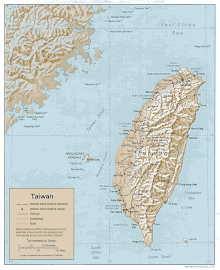Flora of Taiwan

The flora of Taiwan (Chinese: 臺灣植物誌; pinyin: Táiwān Zhíwù Zhì) is rich and varied due to the island's diverse geography and climate zones.[1] The main island is situated on the Tropic of Cancer between China and the Philippine Sea basin. There are mountains in the east, running north and south on two-thirds of the island, with many peaks over 10,000 feet in elevation, and lower, flatter, and more fertile land to the west. The tropical climate, plentiful rainfall, and wide altitudinal range make for abundant and varied vegetation. Taiwan is home to over 4300 species of vascular plants, of which it is estimated that 600 are ferns, 28 are gymnosperms, 2400 are dicots, and 1000 are monocots.[2]
Background
The island can be divided up into seven different
(Green Island); Alpine; upper montaine and supalpine; and lower montane and lowland.The northeastern region of Taiwan receives much more rainfall and cloud coverage than other regions, making the species of this particular region distinct to this particular climate. Species of flora within this region include:
The central region of Taiwan is characterized by basins, and is a plains region mostly surrounded by mountain ranges, such as the Hsueshan Range in the North. The isolated region consists of forests of endemic flora species such as; Castanopsis eyrie, C. kawakamii, Quercus dentata, Q. serrata var. brevipetiolata, Lindera aggregata, Podocarpus nakaii, Ormosia formosana, Quercus (Cyclobalanopsis) globosa, Castanopsis fargesii, Lithocarpus nantoensis.
The
The
The upper
The lower montane/lowland district of Taiwan is more similar to the warm climate forests, supporting
Agricultural flora of Taiwan
Cultivated agriculture has drastically changed Taiwan's development. Agriculture has become as much a part of the naturally existing flora of Taiwan, and human influence on the land has greatly contributed to the vegetation of the country. Bamboo, fruits, grains and vegetable crops all thrive on the island, mostly thriving in the central, southern and eastern regions.
Bamboo has largely taken a hold in the country as a cash crop. Large areas of Taiwan have been converted into various bamboo plantations. Most of the bamboo is grown to support the developing economy; however, the species also provides support to rural communities as its sturdiness provides strength and stands firm in the midst of the high-speed winds that can dominate the country during rainy monsoon seasons.
Fruit trees typically grow in the low-lands of the island. Western and southwestern Taiwan are the primary fruit-producing regions. Fruits commonly grown in Taiwan are tropical and plentiful including lychees, ponkan tangerines, xuegan tangerines, oranges, bananas, grapes, betel nuts, kaochie pear, plum, peach, starfruit, persimmon, guava, papaya, mango, lemon, Indian dates, pineapples, coconuts, apricots, and loquat.
Grain and vegetable crops are mainly cultivated in northern Taiwan. Rice and vegetables are grown in large paddies in the lowlands of the
The major agricultural exports from Taiwan include
See also
- Outline of Taiwan
- Category:Flora of Taiwan
- Category:Endemic flora of Taiwan
- Category:Trees of Taiwan
- Flora of China
References
- ^ Li, Hui-Lin (1963). Woody Flora of Taiwan. Narbeth, PA: Livingston Publishing Co. p. 9.
- ^ Huang, Tseng-Chieng (2003). Flora of Taiwan (2 ed.). Taipei: Department of Botany, National Taiwan University. pp. 1–2.
Notes
- Huang, Tseng-chieng, ed. (2000). Flora of Taiwan Archived 2011-04-16 at the ISBN 957-9019-52-5.
- Li, Hui-Lin (1963-01-01). Woody flora of Taiwan. Narberth, Pa.,.
- "電子書 台灣植物誌第二版 Flora of Taiwan, 2nd edition 1: 1 - Plants of Taiwan 台灣植物資訊整合查詢系統". tai2.ntu.edu.tw. Retrieved 2017-04-21.
- "||| 臺灣大學數位人文研究中心 (Research Center for Digital Humanities)|||". www.digital.ntu.edu.tw. Retrieved 2017-04-21.
